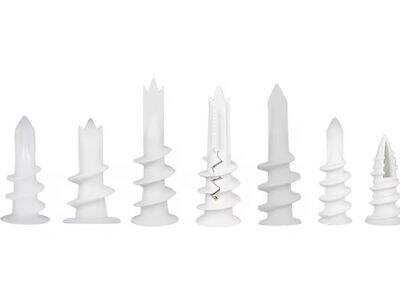Preparing for installation
Preparing for anchor fastener installation is critical when you decide to install these products. The first thing you need in order for our plan to work is preparation. Tools and Materials Required Before Installation That means you’ll need a drill to create holes, a hammer to assist in driving in the anchors and safety wear like goggles to protect your eyes. You’ll also need anchors, which hold things in place, and screws, which attach the items to the anchors. Very critical that the anchors and screws are the same size so they fit snug together.
You drill up through the area, if there is any to drill, but first you need to ensure the surface is safe. That means checking to see where there are any electrical wires or pipes that could be inadvertently damaged when you drill. They are critical components of your home, and you do not want to do them harm. Also, clean the area where you will be placing the anchor. Get rid of any dirt or grime, such as dust or bits of litter. Cleaning lets the anchor grip better and ensures it functions correctly.
Choosing the Right Anchor
Choosing the appropriate anchor fastener for your application is critical. If you select the incorrect one, it may not fit well or even break. There are four types of anchor fasteners you should consider: expansion, torsion, adhesive and mechanical.
These are excellent for concrete surfaces, since once you insert them they're going to expand inside the concrete and hold strong.
If you're working with plaster or drywall, torsion anchors are the way to go. They are engineered to twist and grip tightly when within these materials.
Tile surfaces are ideal for adhesive anchors. They finally use some powerful glue to glue the things in place.
Solid concrete surfaces work best with mechanical anchors. When you tighten them, they lock in to stay secure.
When selecting an anchor, consider how heavy the object you want to attach is and what type of surface you're working with. This is essential since the right kind of anchor is made according to its weight and surface. Plus, be sure to heed the manufacturer’s installation instructions. Follow these instructions to install the anchor safely and properly.
Anchor Down for Stability
Once you select the correct anchor, you should place it optimally for strength. It is also necessary to place an expanding plastic anchor which holds perfectly according to the model. Lean on safety materials, like a level or a measuring tape, to guide you in lining up the anchor correctly before you make the hole. It allows you to ensure that everything is level and in the correct place.
Drill the hole straight and to the proper depth to make the anchor as secure as feasible. The depth varies according to the size and length of the anchor, so be sure to check the anchor’s instructions to find out how deep you need to drill. To achieve optimal outcomes, the anchor must be installed at a length of no less than double that of the screw. So if the screw is 1 inch long, the anchor should go at least 2 inches into the wall. Before tightening the screw, check that the anchor is flush with the surface. An anchor that's too shallow and too deep can impact how well it holds, creating issues down the line.
Tightening the Anchor
With the anchor now in place, it’s time to tighten it. This is particularly critical to ensure the anchor plastic functions as intended. Certain materials may require a hammer to set an anchor, but it’s generally easier to do so with a drill and a screwdriver bit. It enables a simpler and more efficient process.
Begin by hand tightening the screw slowly. This ensures that the anchor is secured and cannot move. Be gentle at first so as not to damage the anchor. Just don't give it too much, or it may ruin or shatter. When the screw is tight, there's a possibility to turn it more for stability. Add an extra turn to ensure that the anchor holds firm and can take the weight of the object you are attaching.
Tricks to Maintain Your Anchors Strong
Once you installed your anchor then there are few tips that you need to take care in order to keep your anchor a last longer. Be sure to periodically review the anchor to ensure it remains secured. This is crucial as over time, anchors may become loose. If you find that your anchor is not holding as it should, it may be time for a new one. Also, don’t weight the anchor too much. All anchors have a limit of how much weight they can hold. If you use it for something it wasn’t designed for, it can fail and may even cause damage.
If the anchor isn’t functioning or appears loose, remove it and install a new one. Better safe than sorry! Over time anchors can loosened which could make them less effective and dangerous to anyone nearby.
Lastly, anchoring fasteners are known to be installed when there are patient and detail-oriented. These fasteners can serve you well for years if you have the right tools, materials, and methods. Just the right one, not the wrong one, and be careful with where you put it and not to pull it too tight. Regular checks on Yifang anchors can provide strong and effective anchor support for your project. As always, be patient and methodical to ensure nothing gets blown up!
 EN
EN
 AR
AR
 BG
BG
 HR
HR
 CS
CS
 DA
DA
 NL
NL
 FI
FI
 FR
FR
 DE
DE
 EL
EL
 HI
HI
 IT
IT
 JA
JA
 KO
KO
 NO
NO
 PL
PL
 PT
PT
 RO
RO
 RU
RU
 ES
ES
 SV
SV
 TL
TL
 IW
IW
 ID
ID
 SR
SR
 UK
UK
 VI
VI
 HU
HU
 TH
TH
 TR
TR
 FA
FA
 MS
MS
 GA
GA
 IS
IS
 LA
LA
 MN
MN
 NE
NE
 KK
KK
 UZ
UZ



